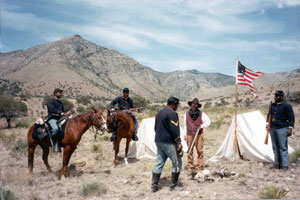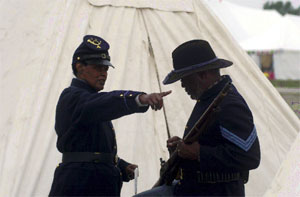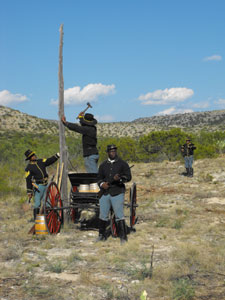Background for Teachers

TPW Magazine, February 2010
If you don't have a copy of the TPW magazine, you may print a copy of Building the West: Buffalo Soldiers(pdf).
Building the West: Buffalo Soldiers
Introduction

Buffalo Soldiers working with a citizen in west Texas
As the American Civil War ended, the United States faced the task of rebuilding the war-torn country. Jobs were hard to find, food was scarce and thousands were homeless. People traveled west to start a new life on the frontier. Contact between American Indians and the ever-increasing number of settlers led to conflicts. The new settlers repeatedly petitioned Congress for an increased military force to protect them from marauding bands of American Indians.
The United States Army had just completed four years of fighting in the American Civil War. Congress decided to reduce the size of the army dramatically. There was a shortage of soldiers to protect the settlers from attacks by Indians, outlaws and thieves. During the Civil War, 186,000 black soldiers who fought for the Union Army realized they had distinguished themselves as soldiers. Congress decided to take advantage of this source of work force and created black cavalry and the infantry regiments.
The Formation of the Black Regiments

Infantry Soldiers of one of the Buffalo Soldier Regiments
In 1866, the United States Congress reorganized the peacetime regular army and authorized two segregated regiments of black cavalry, the Ninth and Tenth United States Cavalry. Congress also authorized the 38th, 39th, 40th and 41st black United States Infantry Regiments. The Buffalo Soldiers went to American frontier to keep peace between the American Indians and settlers moving west. In 1869, Congress consolidated the black infantry regiments into the 24th and 25th U.S. Infantry. These regiments spent the next thirty years on the American frontier helping to build a better nation.
Black soldiers enlisted in the army for many reasons. An important reason was for economic advancement, as well as an opportunity for adventure and recognition. On the way, many received education for the very first time in their lives. They enlisted for five years at a time and privates were paid $13 dollars per month. Each soldier was given a bunk in a barracks, three meals a day, uniforms and medical care. Those who enlisted in the cavalry were also issued a horse.
Many of the black soldiers were newly freed slaves. They were illiterate and had little knowledge of the world outside the cities or plantations on which they had spent their lives. A chaplain was assigned to each regiment of black soldiers, where in addition to his religious duties, the chaplain also taught the Buffalo Soldiers how to read, write, and do basic arithmetic. The new black recruits were also taught the rules and regulations of the United States Army. They were now on the road to becoming among the best soldiers on the American frontier.
The Life of the Black Soldier

Buffalo Soldiers building a telegraph line in west Texas
Much of the work of the Buffalo Soldiers was mundane. They constructed roads, telegraph lines, and forts. Wherever they traveled they also mapped streams, mountain passes, and water holes. Mounted patrols operated from west Texas to Kansas. They provided escort for the transport of goods, mail, and people. The armed security presented by the soldiers was often an effective deterrent for outlaws and Indian raiders. The vast area they patrolled averaged only one soldier for every 120 square miles. The formidable danger and excitement of battle only occasionally interrupted the boredom of construction and escort duty.
These were not the only challenges faced by the Buffalo Soldier on the frontier. Racial prejudices continued to be an issue even after the end of slavery. All of the regiments were commanded by white officers and despite the best efforts of Congress and the Army to prevent it, many treated their soldiers very poorly because the color of their skin. Eventually three black soldiers, the most famous being Henry Flipper, succeeded in becoming officers, but at great personal costs. Only Charles Young served for more than a few years. In addition, the settlers who asked for help from the Army often resented the black soldiers and treated them poorly as a result. Despite these challenges, the Buffalo Soldier persevered against all odds
The name “Buffalo Soldier”
The exact source of the name “buffalo soldier” in not known. The first use of the name Buffalo Soldier was in a letter from 1876. That letter stated that the tribes called the black soldiers “buffalo soldiers.” There are several proposed reasons why the American Indians gave them this title, as different tribes had different reasons. One of the most common stories is the similar hair on the heads of the soldier and the buffalo. Others suggest that the American Indians believed the black soldiers shared the same courage of the sacred buffalo. Eventually, this name became a title of honor for all black service people of the military.
The End of the Indian Wars
By the 1890s, most of the American Indian tribes of the southwest were forced onto reservations. The towns and settlements of west Texas were maintaining a semblance of law and order. To assist with the settlement of the country, many of the Buffalo Soldier regiments transferred north to less populated areas. In 1898, the Spanish-American War erupted in Cuba. The Ninth and Tenth Cavalry Regiment went to fight alongside Teddy Roosevelt and the Rough Riders. The Buffalo Soldiers again distinguished themselves in battle.
Adapted from TPWD’s Buffalo Soldiers on the Texas Frontier, 1866-1898.